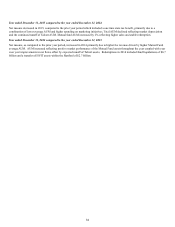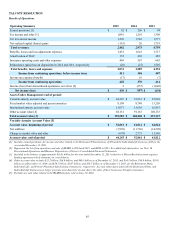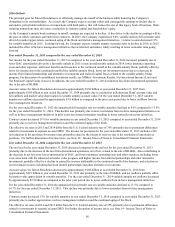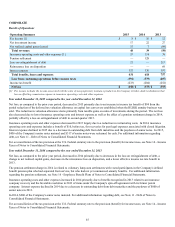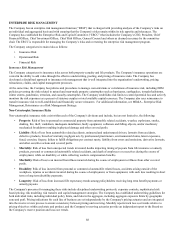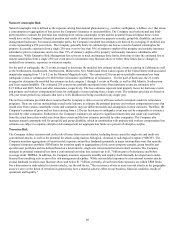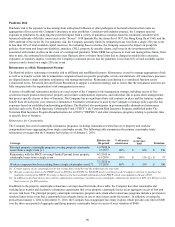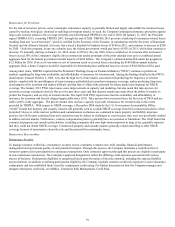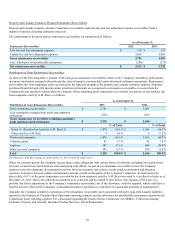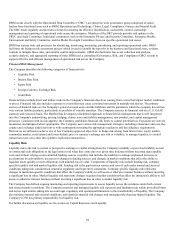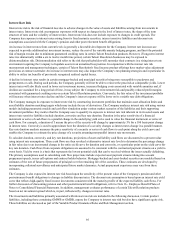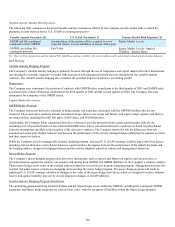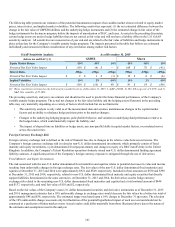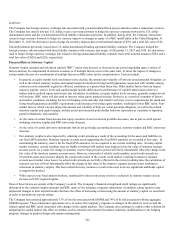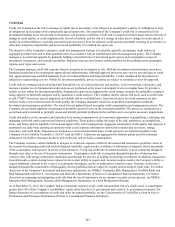The Hartford 2015 Annual Report Download - page 94
Download and view the complete annual report
Please find page 94 of the 2015 The Hartford annual report below. You can navigate through the pages in the report by either clicking on the pages listed below, or by using the keyword search tool below to find specific information within the annual report.94
ORM works closely with the Operational Risk Committee (“ORC”), an enterprise wide governance group comprised of senior
leaders from functional areas such as ORM, Operations and Technology, Claims, Legal, Compliance, Finance and Internal Audit.
The ORC meets regularly and provides a forum for ensuring the effective identification, assessment, control, ownership,
management and reporting of operational risks across the enterprise. Members of the ORC provide periodic risk updates to the
ERCC and Audit Committee. Individual committees, such as the Enterprise Privacy and Security Committee, Enterprise Health,
Environment and Safety Committee, and the Model Oversight Committees focus on specific operational risk issues.
ORM has various tools and processes for identifying, monitoring, measuring, prioritizing, and reporting operational risks. ORM
facilitates the business risk assessment process which is used to identify the top risks in the business and functional areas, evaluate
controls to mitigate those risks, and monitor control improvements. ORM also facilitates loss event collection and analysis,
scenario analysis, and aggregated reporting of risks. ORM uses a centralized Governance, Risk, and Compliance (GRC) system to
support effective and efficient management of operational risk across the Company.
Financial Risk Management
The Company identifies the following categories of financial risk:
• Liquidity Risk
• Interest Rate Risk
• Equity Risk
• Foreign Currency Exchange Risk
• Credit Risk
Financial risks include direct and indirect risks to the Company's financial objectives coming from events that impact market conditions
or prices. Financial risk also includes exposure to events that may cause correlated movement in multiple risk factors. The primary
sources of financial risks are the Company's general account assets and the liabilities and the guarantees which the company has written
over various liability products, particularly its portfolio of variable annuities. The Company assesses its financial risk on a U.S. GAAP,
statutory and economic basis. The Hartford has developed a disciplined approach to financial risk management that is well integrated
into the Company's underwriting, pricing, hedging, claims, asset and liability management, new product, and capital management
processes. Consistent with its risk appetite, the Company establishes financial risk limits to control potential loss. Exposures are actively
monitored, and mitigated where appropriate. The Company uses various risk management strategies, including reinsurance and over-the-
counter and exchange traded derivatives with counterparties meeting the appropriate regulatory and due diligence requirements.
Derivatives are utilized to achieve one of four Company-approved objectives: to hedge risk arising from interest rate, equity market,
commodity market, credit spread and issuer default, price or currency exchange rate risk or volatility; to manage liquidity; to control
transaction costs; or to enter into synthetic replication transactions.
Liquidity Risk
Liquidity risk is the risk to current or prospective earnings or capital arising from the Company's inability or perceived inability to meet
its contractual cash obligations at the legal entity level when they come due over given time horizons without incurring unacceptable
costs and without relying on uncommitted funding sources. Liquidity risk includes the inability to manage unplanned increases or
accelerations in cash outflows, decreases or changes in funding sources, and changes in market conditions that affect the ability to
liquidate assets quickly to meet obligations with minimal loss in value. Components of liquidity risk include funding risk, company
specific liquidity risk and market liquidity risk. Funding risk is the gap between sources and uses of cash under normal and stressed
conditions taking into consideration structural, regulatory and legal entity constraints. Company specific liquidity risk represents
changes in institution-specific conditions that affect the Company's ability to sell assets or otherwise transact business without incurring
a significant loss in value. Market liquidity risk represents changes in general market conditions that affect the institution's ability to sell
assets or otherwise transact business without incurring a significant loss in value is market liquidity risk.
The Company has defined ongoing monitoring and reporting requirements to assess liquidity across the enterprise under both current
and stressed market conditions. The Company measures and manages liquidity risk exposures and funding needs within prescribed limits
and across legal entities taking into account legal, regulatory and operational limitations to the transferability of liquidity. The Company
also monitors internal and external conditions, and identifies material risk changes and emerging risks that may impact liquidity. The
Company's CFO has primary responsibility for liquidity risk.
For further discussion on liquidity see the section on Capital Resources and Liquidity.


